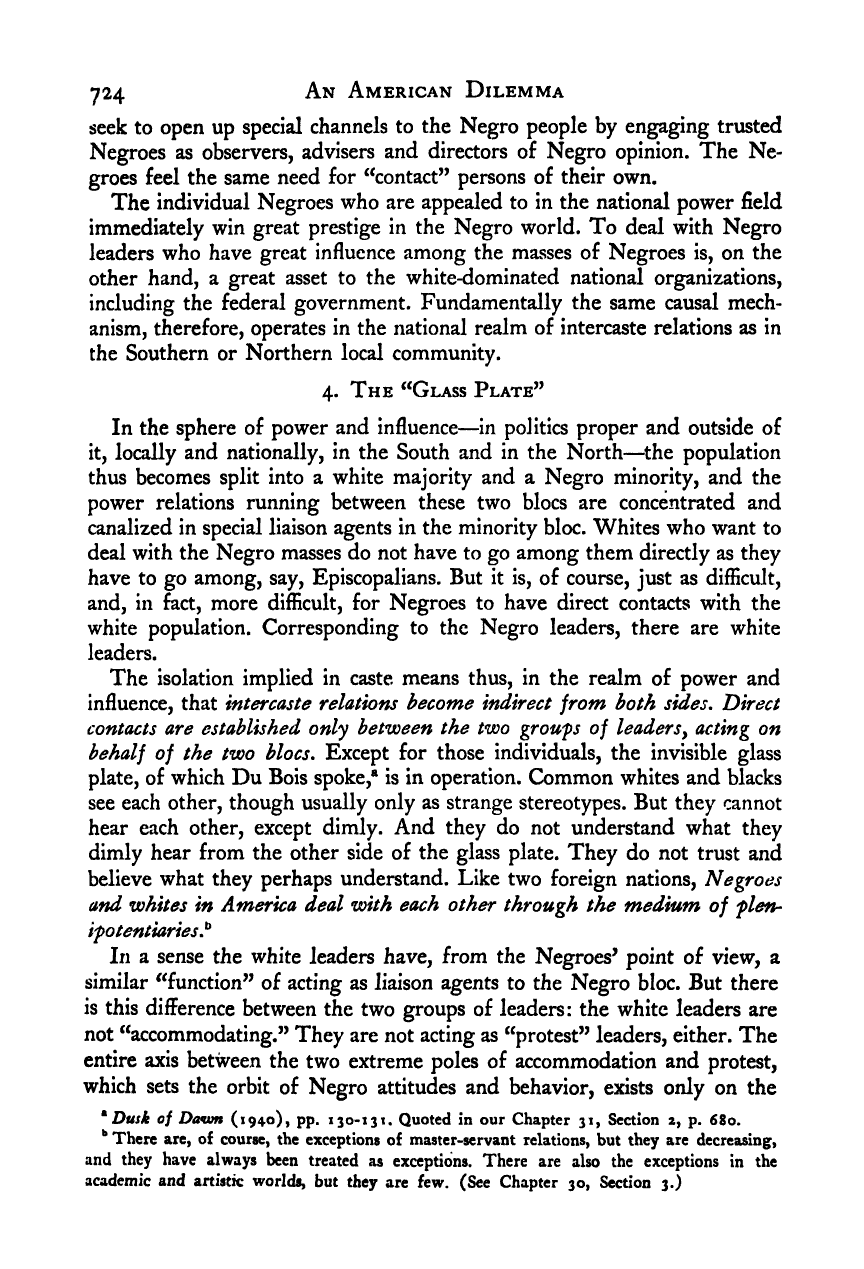Note: Gunnar Myrdal died in 1987, less than 70 years ago. Therefore, this work is protected by copyright, restricting your legal rights to reproduce it. However, you are welcome to view it on screen, as you do now. Read more about copyright.
Full resolution (TIFF) - On this page / på denna sida - IX. Leadership and Concerted Action - 34. Accommodating Leadership - 3. In the North and on the National Scene - 4. The “Glass Plate”

<< prev. page << föreg. sida << >> nästa sida >> next page >>
Below is the raw OCR text
from the above scanned image.
Do you see an error? Proofread the page now!
Här nedan syns maskintolkade texten från faksimilbilden ovan.
Ser du något fel? Korrekturläs sidan nu!
This page has never been proofread. / Denna sida har aldrig korrekturlästs.
*724 An American Dilemma
seek to open up special channels to the Negro people by engaging trusted
Negroes as observers, advisers and directors of Negro opinion. The Ne-
groes feel the same need for ^^contact” persons of their own.
The individual Negroes who are appealed to in the national power field
immediately win great prestige in the Negro world. To deal with Negro
leaders who have great influence among the masses of Negroes is, on the
other hand, a great asset to the white-dominated national organizations,
including the federal government. Fundamentally the same causal mech-
anism, therefore, operates in the national realm of intercaste relations as in
the Southern or Northern local community.
4. The ^‘Glass Plate”
In the sphere of power and influence—in politics proper and outside of
it, locally and nationally, in the South and in the North—^the population
thus becomes split into a white majority and a Negro minority, and the
power relations running between these two blocs are concentrated and
canalized in special liaison agents in the minority bloc. Whites who want to
deal with the Negro masses do not have to go among them directly as they
have to go among, say. Episcopalians. But it is, of course, just as difficult,
and, in fact, more difficult, for Negroes to have direct contacts with the
white population. Corresponding to the Negro leaders, there are white
leaders.
The isolation implied in caste means thus, in the realm of power and
inffuence, that intercaste relations become indirect from both sides. Direct
contacts are established only between the two groufs of leaders, acting on
behalf of the two blocs. Except for those individuals, the invisible glass
plate, of which Du Bois spoke,® is in operation. Common whites and blacks
see each other, though usually only as strange stereotypes. But they cannot
hear each other, except dimly. And they do not understand what they
dimly hear from the other side of the glass plate. They do not trust and
believe what they perhaps understand. Like two foreign nations, Negroes
and whites in America deal with each other through the medium of flen-
ifotentiaries}^
In a sense the white leaders have, from the Negroes’ point of view, a
similar ^Tunction” of acting as liaison agents to the Negro bloc. But there
is this difference between the two groups of leaders: the white leaders are
not ^^accommodating.” They are not acting as ‘^protest” leaders, either. The
entire axis between the two extreme poles of accommodation and protest,
which sets the orbit of Negro attitudes and behavior, exists only on the
^ Dusk of Dawn (1940), pp. 130-131, Quoted in our Chapter 31, Section 2, p. 680.
**
There are, of course, the exceptions of master-servant relations, but they are decreasing,
and they have always been treated as exceptions. There are also the exceptions in the
academic and artistic worlds, but they are few. (See Chapter 30, Section 3.)
<< prev. page << föreg. sida << >> nästa sida >> next page >>